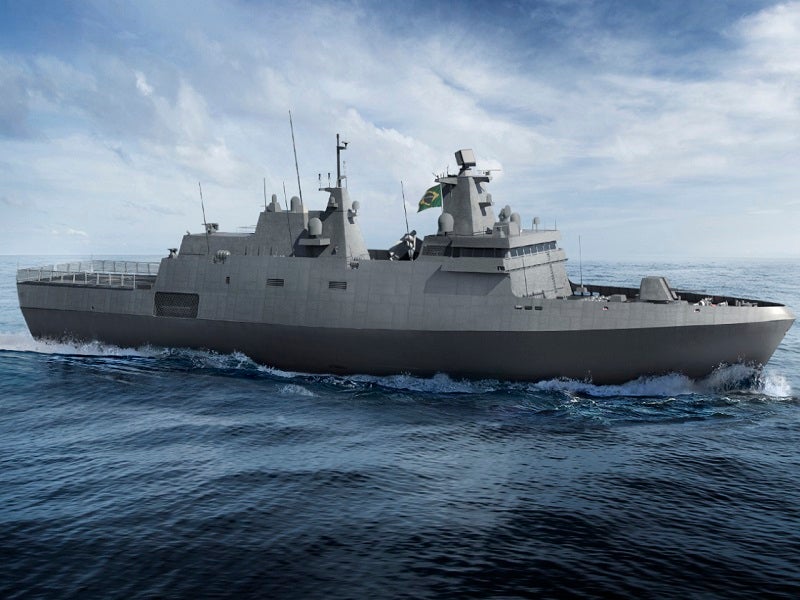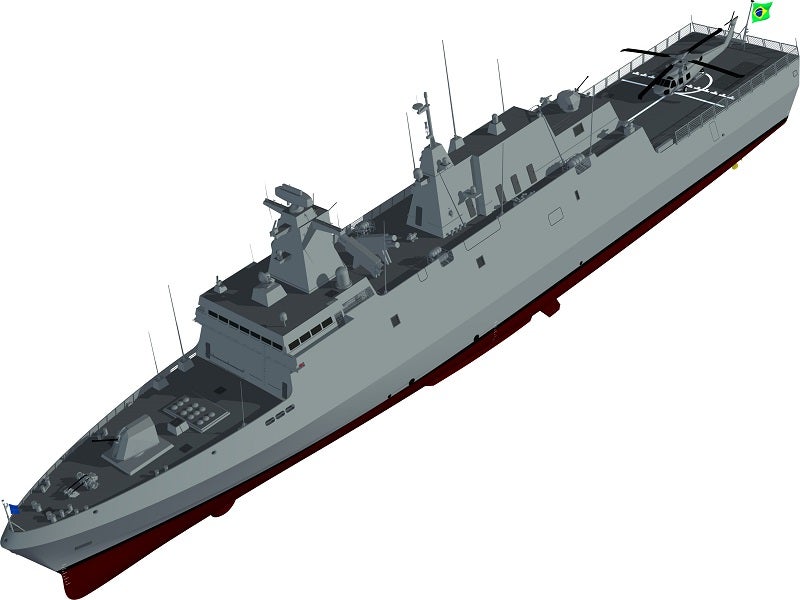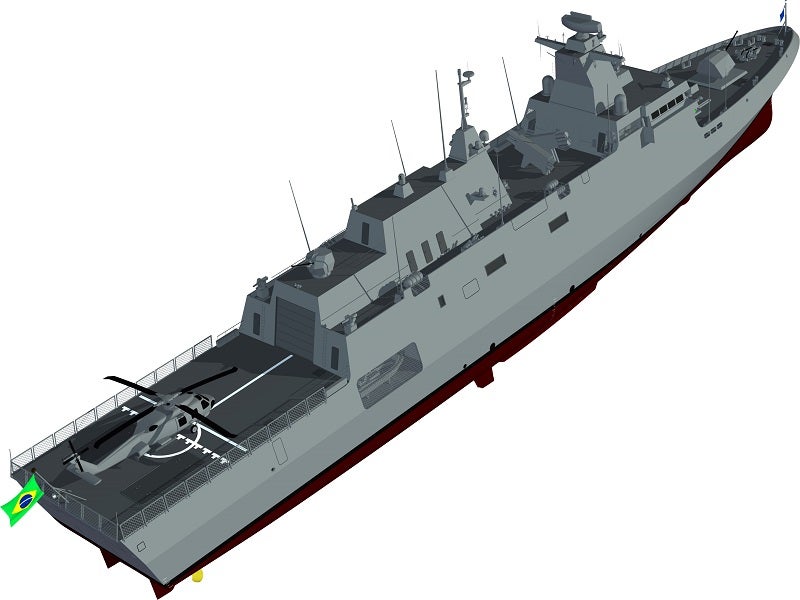Tamandare-class frigates are being built by Aguas Azuis, a consortium formed by Thyssenkrupp Marine Systems, Embraer Defense & Security and Atech, for the Brazilian Navy.
The construction of four multi-mission frigates is a part of the Brazilian Navy’s strategic Tamandare Corvettes Class Programme (CCT) to expand and modernise their fleet, to ensure national territorial sovereignty and protect the country’s natural resources. The CCT programme will contribute to the Brazilian economy by generating more than 1,000 direct and about 4,000 indirect jobs.
The frigates will serve as escort ships with superior combat capability to ensure the safety of maritime traffic. The vessels will inspect and protect the exclusive economic zone, which together makes up the Blue Amazon, spanning over 4.5 million square kilometres of maritime area. It can carry out defence missions at the Brazilian coast and can be deployed in patrol operations in the Brazilian jurisdictional waters. The ships will also play an important role in peacekeeping and humanitarian relief missions.
Scheduled to begin in the second half of 2021, the construction will take place completely in Brazil at the Thyssenkrupp shipyard located in Itajai, Santa Catarina state. The frigates are scheduled for delivery between 2024 and 2029.
Tamandare-class frigates design and features
Based on Thyssenkrupp Marine Systems’ MEKO® A100 design, the Tamandare-class frigate will have a displacement of 3,500t. Each vessel will have a length of 107.2m, a width of 15.95m and a draft of 5.2m. The frigate will feature stealth characteristics for minimising radar signature.
The MEKO-Class with exceptional autonomy is an ideal escort vessel for operations in blue waters. The modular design concept of MEKO allows local integration and technology transfer, reducing maintenance and modernisation costs.
The vessel will be manned by 136 crew members. It can carry an unmanned vertical take-off and landing aircraft (drone) and a helicopter capable of performing anti-submarine (ASW) missions.
Weapon systems
The new Tamandare-class frigates will be equipped with Sea Ceptor, a smart weapon control system (WCS), to protect themselves, consorts, and fixed infrastructure against a range of threat types at sea or in harbours, as well as in the most challenging operating situations.
The Sea Captor air defence missile system in combination with the fully operational Common Anti-air Modular Missile (CAMM) offers comprehensive self-defence and local area air defence (LAAD).
Each ship will integrate two twin launchers for the MANSUP (AV-RE40) anti-ship missiles and two triple torpedo launchers for Mark 46 anti-submarine torpedoes.
The frigates will also be armed with a Leonardo OTO Melara SRGM 76/62mm multi-purpose naval gun, a SeaSnake remote-controlled close-in weapon system (CIWS), and two Sea defender remote weapon stations (RWS) mounted with 12.7mm remote-controlled guns.
Sensors/radars on Tamandare-class frigates
The vessel will feature Raytheon X- and S-band radars, an Atlas Elektronik ASO 713 hull-mounted sonar, a Hensoldt TRS-4D multi-function surveillance and target acquisition radar and a Thales STIR is a medium-to-long-range fire-control radar.
Each Tamandare-class frigate will be outfitted with two Safran’s Paseo extra-long range (XLR) optronic (electro-optical) sights to increase the safety zone around ships, improving the navy’s ability to combat conventional as well as asymmetrical threats.
The Paseo XLR sight integrates modules from Safran’s Euroflir optronic system, particularly high-definition sensors combined with a multispectral telescope to spot threats on the horizon. It can also identify small vessels that are difficult to detect by conventional radar systems since they are close to the sea surface and made of radar-transparent composite materials.
Paseo XLR will detect and identify numerous threats as part of the ship’s self-protection system, even in stormy seas, at high speeds, and in low-visibility conditions.
The Atlas-ANCS naval combat management system (CMS) on board the ship will be interfaced with the shipboard sensors, data and weapon systems as well as other equipment.
Communication systems
The frigates will be installed with the external and internal communication suite. It will feature external communications architecture NAVICS®, a modern and complete IP-based integrated communications system, and advanced antenna systems.
In addition to external communications, NAVICS will provide on-board communications and will assure a multilayer security architecture that permits safe, trustworthy, and tamper-proof communications.
The C-ESM passive sensor and antenna systems will allow the frigate to use the electromagnetic spectrum and enemy communications to combat conventional and asymmetric threats across the coastlines, national boundaries, and logistics routes.
Tamandare-class propulsion
The new Tamandare-class frigates will be equipped with a two-shaft propulsion system integrating four MAN 12V 28/33 DSTC diesel engines and four Caterpillar C32 diesel generators. The maximum design speed of Tamandare-class frigates is 28k.
The L3 MAPPS’ integrated platform management system (IPMS) aboard the vessel will monitor and control onboard equipment including propulsion, electrical, auxiliary and damage control systems.
Contractors involved
The Brazilian Navy contracted Aguas Azuis consortium to build four state-of-the-art Tamandare-class ships in March 2019. The first vessel will be constructed with more than 30% local content and the others with 40%.
In addition to construction, the contract includes a sustainable transfer of naval engineering technology for the construction of military ships, platform and combat systems, and integrated logistical support and life cycle management.
MBDA will provide the Sea Ceptor air defence missile system, while Safran Electronics & Defense Brazil, a subsidiary of Safran Electronics & Defence, will provide Paseo XLR optronic (electro-optical) sight as well as customer support services including spare parts and repairs for the new Tamandare-class frigates.
Rohde & Schwarz will supply communications and intelligence suites for the frigates. It will be responsible for the development, design, manufacturing, integration, and acceptance of the external and internal communication suites, and the supply of communication electronic support measures (C-ESM).
Heinen & Hopman will oversee the whole system integration of the heating, ventilation, air conditioning and refrigeration (HVAC-R) systems aboard Tamandare-class vessels.





